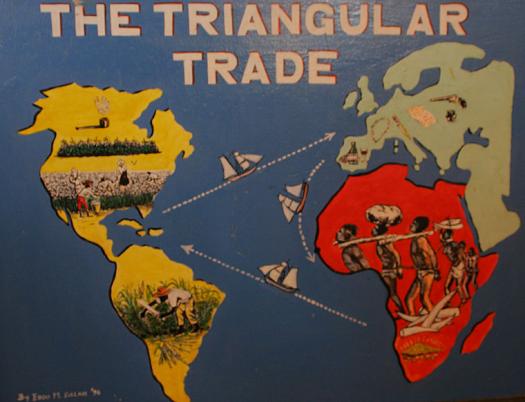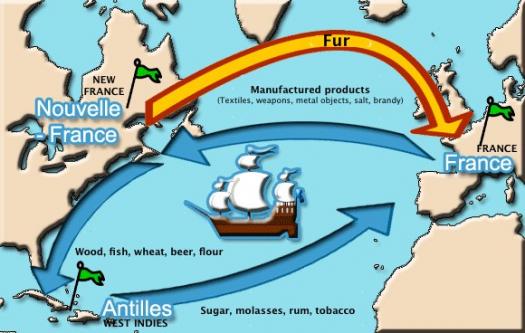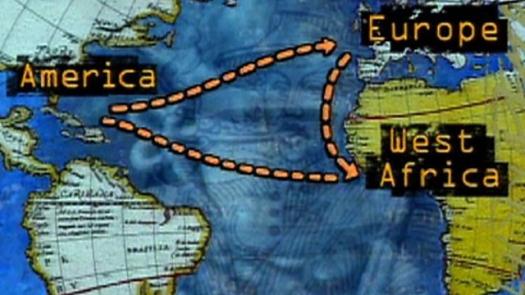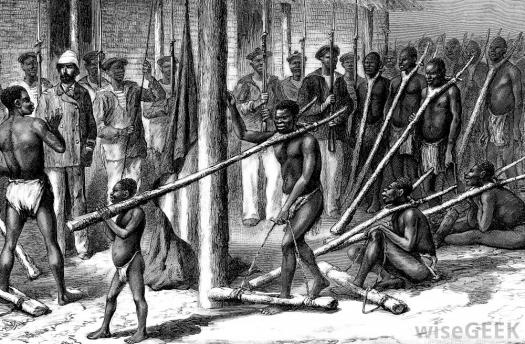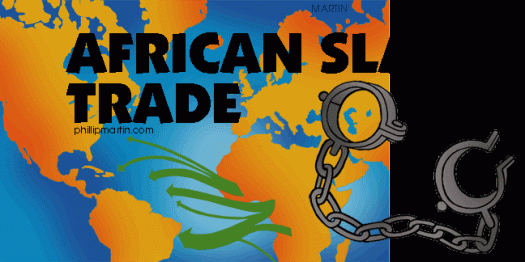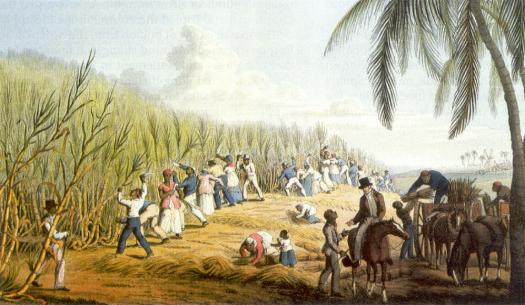History Quiz: The Triangular Trade System
(233).jpg)
The Triangular trade system was one complicated and dark part of our history. Even though this trading point was the economic gain, the fact that slaves were traded for other products is quite devastating. It's important to learn from our past; that's why today's quiz is all about the Triangular Trade system!
- 1.
Across which ocean did the Triangular trade happen?
- A.
Southern ocean
- B.
Indian ocean
- C.
Pacific ocean
- D.
Atlantic ocean
Correct Answer
D. Atlantic oceanExplanation
The Triangular trade refers to the trade system that occurred between Europe, Africa, and the Americas during the 16th to 19th centuries. It involved the exchange of goods, including slaves, between these three regions. The Atlantic Ocean was the main route for this trade, connecting the continents involved. Therefore, the correct answer is Atlantic Ocean.Rate this question:
-
- 2.
When does the triangular trade usually happen?
- A.
When a region has too many good of one kind and it's forced to lower the prices
- B.
When a region has no or little goods of one kind and it's forced to import them at a much larger price
- C.
When a region is exporting resources that are not needed in the region from which its main imports come
- D.
When a region decides to establish contacts with foreign reigns
Correct Answer
C. When a region is exporting resources that are not needed in the region from which its main imports comeExplanation
The triangular trade usually happens when a region is exporting resources that are not needed in the region from which its main imports come. This trade pattern involves three regions, with each region exporting goods to one region and importing goods from another region. In this case, the region is exporting resources that are surplus or not in demand in the region from which it primarily imports goods. This trade allows the region to exchange its excess resources for needed goods, creating a triangular trade network.Rate this question:
-
- 3.
What was the best known Triangular trading system?
- A.
Indian trade system
- B.
Pacific trade system
- C.
Atlantic slave trade
- D.
Triangular slave system
Correct Answer
C. Atlantic slave tradeExplanation
The Atlantic slave trade was the best known triangular trading system. This trade involved the transportation of African slaves from West Africa to the Americas, where they were sold and forced into labor on plantations. The triangular aspect of this trade refers to the three legs of the journey: European ships would travel to Africa with goods to trade for slaves, then transport the slaves to the Americas, and finally return to Europe with goods produced by the enslaved labor. This system was highly profitable for European countries and played a significant role in the development of the New World colonies.Rate this question:
-
- 4.
Which period did the Atlantic slave system function in?
- A.
late 16th to early 19th century
- B.
late 15th to early 18th century
- C.
late 16th to early 17th century
- D.
late 17th to early 20th century
Correct Answer
A. late 16th to early 19th centuryExplanation
The Atlantic slave system functioned from the late 16th to the early 19th century. This period corresponds to the time when millions of African people were forcibly captured, transported, and enslaved in the Americas by European powers. The slave trade was at its peak during this time, with large numbers of slaves being transported across the Atlantic Ocean to work on plantations and in other industries. The system finally began to decline in the early 19th century due to a combination of factors including abolitionist movements and economic changes.Rate this question:
-
- 5.
What's the first leg of the triangular trade?
- A.
It was from a European port to Africa, in which ships carried supplies for sale and trade.
- B.
The ships made the journey of the Middle Passage from Africa to the New World.
- C.
The return of the ships back to Europe
- D.
The journey from Africa to Europe.
Correct Answer
A. It was from a European port to Africa, in which ships carried supplies for sale and trade.Explanation
The first leg of the triangular trade was from a European port to Africa, in which ships carried supplies for sale and trade. This leg involved European merchants bringing goods such as textiles, firearms, and alcohol to Africa in exchange for enslaved Africans. These enslaved individuals would then be transported to the New World in the Middle Passage, which was the second leg of the triangular trade. The correct answer accurately describes the initial journey of European ships to Africa to engage in trade and acquire enslaved Africans.Rate this question:
-
- 6.
Which colonial region was rich with farms, grains, navigable rivers and mild climate?
- A.
New England
- B.
Southern colonies
- C.
Middle colonies
- D.
All of the above
Correct Answer
C. Middle coloniesExplanation
The middle colonies were rich with farms, grains, navigable rivers, and a mild climate. This region, consisting of Pennsylvania, New York, New Jersey, and Delaware, had fertile soil and a longer growing season compared to New England. The navigable rivers provided easy transportation for trade and commerce. The middle colonies were known for their diverse agricultural production, including wheat, corn, and livestock. The combination of these factors made the middle colonies a prosperous region for farming and economic growth.Rate this question:
-
- 7.
Which of these products did the Europeans trade in for slaves?
- A.
Grains
- B.
Jewels
- C.
Molases
- D.
Guns
Correct Answer
D. GunsExplanation
During the era of European colonization, Europeans traded guns in exchange for African slaves. The Europeans used these guns to establish dominance and control over African societies, making it easier for them to capture and transport slaves. The introduction of guns disrupted the balance of power, leading to increased warfare and conflict among African tribes. The Europeans exploited this situation to acquire slaves, who were then transported to the Americas to work on plantations and in mines. Therefore, guns played a crucial role in facilitating the transatlantic slave trade.Rate this question:
-
- 8.
Which product did the Americans export to England?
- A.
Tobacco
- B.
Grains
- C.
Molasses
- D.
Gun powder
Correct Answer
A. TobaccoExplanation
The correct answer is tobacco. This is because tobacco was a major product that the Americans exported to England during the colonial period. It was highly valued in England and played a significant role in the economic relationship between the two countries. Tobacco cultivation and trade were crucial to the development of the American colonies and their ties to the British Empire.Rate this question:
-
- 9.
Why were African slaves needed in America?
- A.
To produce cash corps
- B.
To work as teachers
- C.
To trade for rum
- D.
To ensure a larger number of converted people to Christianity
Correct Answer
A. To produce cash corpsExplanation
African slaves were needed in America to produce cash crops. This was because the demand for crops such as tobacco, rice, and indigo was increasing, and there was a need for a large labor force to cultivate and harvest these crops. Slavery provided a cheap and easily controlled workforce that could be used for the intensive labor required in agriculture.Rate this question:
-
- 10.
What's the name of the passage from Africa to America?
- A.
Triangular Passage
- B.
Middle Passage
- C.
Transatlantic Passage
- D.
Bermuda Triangle
Correct Answer
B. Middle PassageExplanation
The correct answer is Middle Passage. The Middle Passage refers to the route used to transport enslaved Africans from Africa to the Americas during the transatlantic slave trade. It was called the Middle Passage because it was the middle leg of the triangular trade route, with the first leg being from Europe to Africa, and the final leg being from the Americas back to Europe. This passage was notorious for its harsh conditions, high mortality rates, and the inhumane treatment of enslaved Africans.Rate this question:
-
Quiz Review Timeline +
Our quizzes are rigorously reviewed, monitored and continuously updated by our expert board to maintain accuracy, relevance, and timeliness.
-
Current Version
-
Mar 21, 2023Quiz Edited by
ProProfs Editorial Team -
Jun 27, 2018Quiz Created by
EnidaK0909
- African American History Quizzes
- Age Of Exploration Quizzes
- American History Quizzes
- Australian History Quizzes
- Black History Quizzes
- Canadian History Quizzes
- Chinese Dynasty Quizzes
- Chinese History Quizzes
- Civilization Quizzes
- Colonialism Quizzes
- Colonization Quizzes
- Elizabethan Era Quizzes
- European History Quizzes
- French Revolution Quizzes
- Georgia History Quizzes
- Gothic Quizzes
- History Midterm Quizzes
- Indian History Quizzes
- Mesopotamia Quizzes
- Middle Ages Quizzes
- Modern History Quizzes
- Philippine History Quizzes
- Renaissance Quizzes
- The Rise Of Hitler Quizzes
- United States Constitution Quizzes
- War Quizzes
- Westward Expansion Quizzes
- World War I Quizzes
- World War II Quizzes
 Back to top
Back to top






